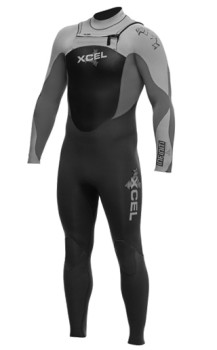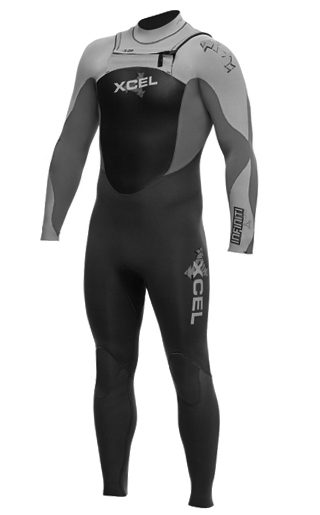
The 4/3 full wetsuit is widely considered the most versatile wetsuit on the market today (widely = by me). It is a full suit which makes it good for quite cold water conditions, and the 4/3 thickness covers a really nice range of temperatures. Most people don’t surf in very cold waters which require the 5/4 or more so 4/3 is more than enough for almost everyone.
Since it is a full suit your whole body is covered except your head, hands and feet. If you start getting cold you can always purchase gloves, booties and a hood to help keep you even warmer and extend the range of use for this wettie.
The 4/3 means that most of the wetsuit is made using 4 millimeter thick neoprene. Only areas around your arms and shoulders which need more flexibility have 3 millimeters. This is winter suit, especially when combined with a hood, gloves and booties. You can wear it in warmer waters, if you get too hot you can just let some water into the suit to cool you down. It would be ideally to have a 3/2 a 4/3 and a 5/3 but if you only have one – get a 4/3.
What Do You Want in a 4/3 Winter Wetsuit
- High Quality Neoprene – 4/3 suits are a good thickness which will keep you warm, but also slow you down while paddling. Getting a suit made from high quality stretchy neoprene will help you stay flexible.
- Blind stitches – A blind stitched wetsuit will help keep the water out of the suit. Blind stitching is a technique which does not puncture all the way through the material so you don’t have any water leaking in.
- Sealed Seams – Sealing the seams with liquid taping or liquid sealing will help keep even more water out and thus, keep more warmth in. This is very important for winter wetsuits.
- Additional Insulation – Choosing a suit with thermal lining on the inside will help keep you warmer.
- Short Zipper – A shorter zipper means less water getting through it. You can also get special zippers with teeth designed to keep out water drops. But I guess no zipper is 100% waterproof.
- Batflap – A batflap is a layer of neoprene which goes under the zipper to help stop any water which does get through the zipper. It then directs that water down through a small hole at the bottom and out of the wetsuit.
If you want to learn more about which wetsuit goes with which water temperature and what are the factors that influence the feeling of cold check this article.


